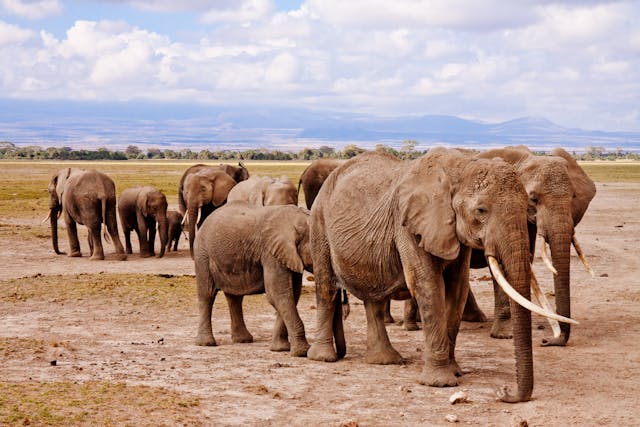
Are elephants the only source of ivory? No. Ivory comes from many other animals, besides elephants. It is also possible to make synthetic ivory.
Ivory is a hard, white substance that forms the teeth and tusks of a lot of animals. It is made of dentine, which is a form of bone. The inside of our teeth is made of dentine as well, and then covered with a layer of enamel to protect it from wear and tear. Dentine is made of a similar material to bone, but it is not bone. Bone contains collagen, which is living growing tissue, which means that bones can heal when they are damaged. Dentine is calcified tissue, which means that the collagen is dead and can no longer grow. That is why a broken tooth or a cavity cannot heal itself. Dentine can be brittle, so it is always coated in enamel. The same is true even of elephant tusks, which are wrapped in layers of enamel to protect them.
Ivory has been used for thousands of years as a decorative material. Figures and religious works of art were carved out of it. It was used to decorate sword hilts and even for regular items like pipes. Some ivory is very easy to carve but the enamel sometimes has to be removed before it is carved. It is possible to make very fine details and the carved ivory will last for a very long time. Archaeologists have discovered an ivory carving called the Venus of Brassempouy that is 25,000 years old. Ivory has always been fairly rare and expensive, which made it something of a status symbol. It was so valuable it was known as “white gold”. Up until the 19th century, elephants were hunted by hand and it was hard to kill a lot of elephants. It was sustainable because they couldn’t kill more elephants than there were. In the 19th century, with the invention of guns, international trade, and increasing colonization, the number of elephants killed for ivory went into overdrive and populations were wiped out.
We commonly think of ivory as coming from elephants, and the majority of it does, but ivory is also produced by walruses, hippopotamuses, sperm whales, orcas, narwhals, warthogs, and elks. Mammoths, which are related to elephants, also produced enormous tusks that can sometimes still be found in the permafrost. It is made of the same material as teeth, because these animals’ tusks are basically extended teeth. They mustn’t be confused with horns, which are made of keratin. The tusk on an elephant is the upper incisor that has just continued growing. Your incisors are the front teeth at the top of your mouth. The elephant’s tusks grow through the skin, and curve, growing to a length of about 3.5 m. Each year, they grow more and layers of ivory are added over the previous layers. They stop growing at about 3.5 m because they would become too hard to use if they got much longer. Mammoths were even larger than elephants are and their tusks probably reached close to 5 m in length. Elephant tusks are covered in enamel for protection and the elephants use them for fighting, protection, carrying things, scraping bark off trees, and many other tasks. Without their tusks, they have a hard time. The tusk is an elongated tooth, so it has the nerves inside that our teeth have.
So, elephants aren’t the only animals to produce ivory. All animals with tusks, and there are a lot of them, produce ivory. Why, then, is elephant ivory most commonly used? The first reason is the size of it. Elephants have tusks that are larger than any of the other animals, and they have two of them. Secondly, elephants are fairly common, and they are land dwelling animals. Whale ivory is obviously far more difficult to hunt. Thirdly, elephants are easier to hunt than some of the other animals. Their large size makes them easy to find and they are less aggressive than the hippo, which is known to attack anything. And fourthly, their ivory is easier to carve. The enamel on the tusks of a hippo is as hard as rock and needs to be ground off before the ivory can be used. Elephant ivory is softer and easier to work. Unfortunately, all of these reasons mean that many elephant species have been hunted to extinction. Luckily, the sale of ivory is illegal now, but people still poach elephants because there is always a black market. It is estimated that 20,000 elephants a year are poached.
These days, synthetic ivory is possible. Scientists have worked out that they can 3D print ivory using a mixture made from gelatin and a bio-mineral called hydroxylapatite. When the liquid sets, it is almost indistinguishable from real ivory. If you cut it in half, you could probably tell, but it has the same feel, look, and weight of real ivory. Plus, no animals have had to die to make it. It is actually being considered as a replacement for some plastics because it is far more environmentally friendly. And this is what I learned today.
Photo by Pixabay: https://www.pexels.com/photo/group-of-elephants-on-walking-on-brown-road-during-daytime-50611/
Sources
https://www.ifaw.org/international/journal/what-is-ivory
https://en.wikipedia.org/wiki/Ivory
https://manual.museum.wa.gov.au/book/export/html/63/index.html
https://www.livescience.com/33130-why-are-teeth-not-considered-bones.html
https://www.worldwildlife.org/stories/what-is-ivory-and-why-does-it-belong-on-elephants
https://www.bbc.com/news/science-environment-63931103
https://www.discoverwildlife.com/animal-facts/what-is-ivory-and-is-it-exclusive-to-elephants
